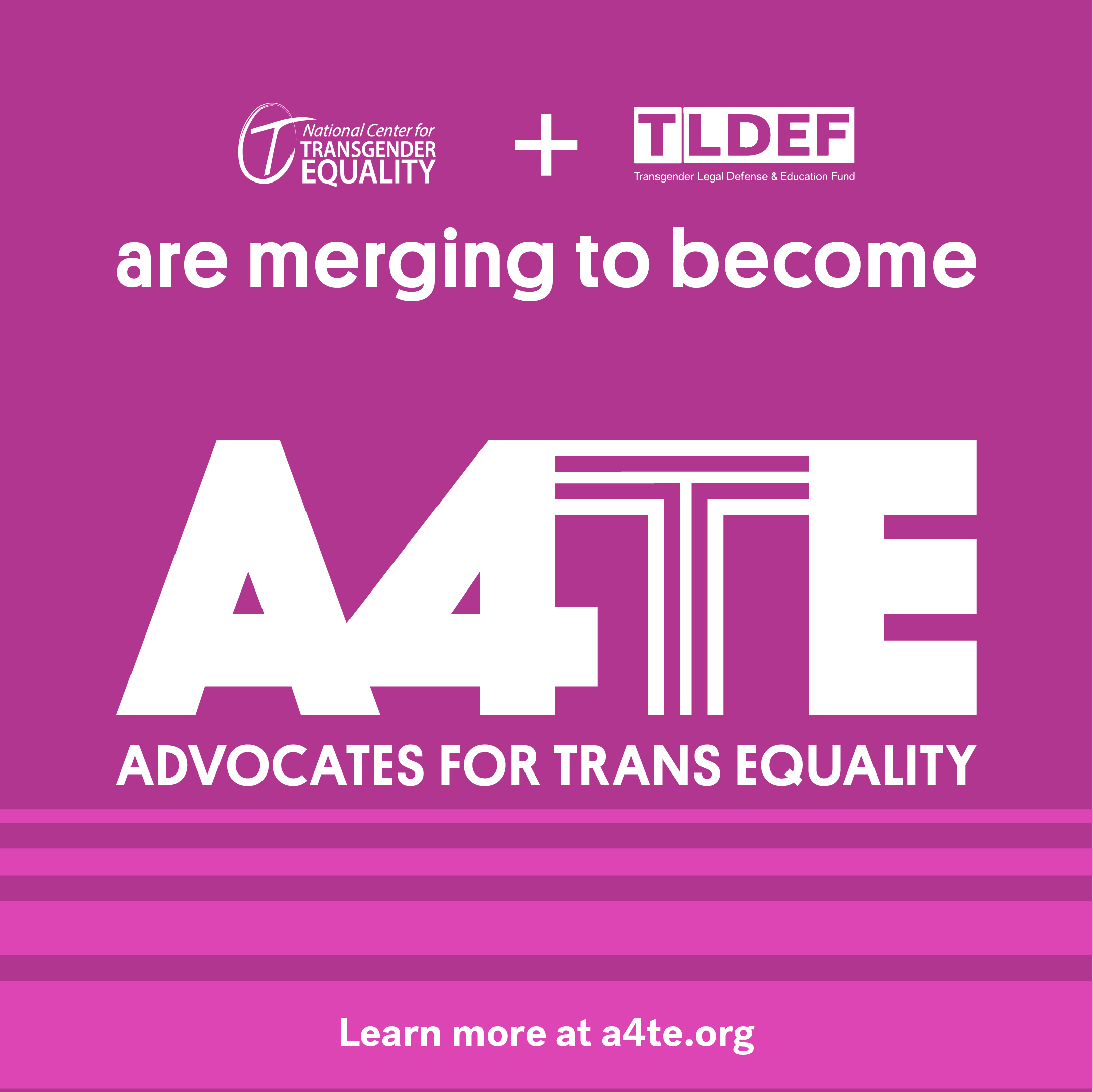When you are traveling, what should you do?

From Mara Keisling
We work hard at NCTE to provide solid, useful advice to the community. What advice to give isn’t always perfectly clear, though. Over the last few months, we’ve had several policy areas in which we have tried to convey information but have been unable to give unequivocal advice. The questions we have received most frequently since just before Thanksgiving have been about the new TSA security protocols and this has been an especially challenging issue for us to unequivocally tell trans people the best way to avoid being demeaned in potentially traumatic ways. The new TSA procedures, in addition to being ineffective and counter to American privacy standards also present trans people with an array of bad choices, each potentially as disheartening and potentially dangerous as the next. Let me explain. It is really important that people refrain from panic and make rational decisions. The truth is that most trans people are not experiencing significant problems when flying—even when faced with whole body scanners and enhanced pat downs. But some are not. And I understand that refraining from panic or anger can be hard when an irrational and ineffective system is set up and forced upon us. First, let me say that we have been working with the TSA on trans education for several years. And, along with allies, we have specifically been in touch with them on multiple occasions since the new patdown protocols were implemented. We are hopeful that the TSA will soon issue guidance and training for their officers about transgender people and our issues. We are NOT hopeful that the TSA will reverse itself and eliminate either the enhanced patdowns or the whole body imagers in the near future but we’ll keep working at it. Still we are in pretty frequent contact with the civil rights office at TSA and with members of Congress. For now, here’s where we are. We are suggesting that all trans people—and gender non-conforming people regardless of whether they are trans-identified—carefully consider their choices. Trans people who have genitals and chests that generally fit with what most TSA agents would expect probably are at no greater risk of disrespect or indignity than they were before whole body scanners and enhanced patdowns. Realistically, though, that’s not most of us. One choice, of course, is to not fly. That isn’t a choice for many people though, and additionally, in recent months there has been more and more official talk about starting to implement tighter security on other forms of transportation including trains, subways and ferries. The DC subway system, for instance, just implemented a random bag search. Hopefully this won’t spread too much, but who knows? Remember, lots of transgender people fly everyday and most get through all security with no significant hassles or indignities. We have heard a handful of extremely horrible stories and there are no doubt more out there that we haven’t heard, but more trans people than not report flying safely and comfortably. And also remember, this isn’t just a trans problem. It is also causing terrible problems for people of various religions (Orthodox Jewish women with wigs, Sikhs with ceremonial daggers [kirpan], chemotherapy patients with chemo pumps, people with prosthetic limbs, etc). Here is a good article that discusses this: http://www.washingtonpost.com/wp-dyn/content/article/2010/12/22/AR2010122202919.html. So, for those who do need to or want to fly, there are things you can do that can minimize the likelihood of a serious privacy problem. These are listed on our new resource at http://transequality.org/Resources/KYR_TSA.pdf. We also have resources with more details about the whole body image scanners and about recent TSA booking requirements. This is a really great resource that presents the information I’m giving here in a more systematic way. In short though, here are some things to think about if you are flying while trans. Any meds, needles, etc, that you can put in checked luggage, the better. Transportation Security Officers (TSOs) are trained to look for anomalies--that is things that are different than expected. More specifically, in terms of the scanners, which allow them to see all your body contours under your clothes, they are looking for foreign objects. They are designed to find guns, explosives, drugs, etc., but they can also see--and overreact to--binders, packers, wigs, breast forms.) Any of these things, while completely legal to travel with, may attract attention of TSOs and lead to increased scrutiny of your person. There are only about 500 whole body scanners deployed at US airports with another 500 planned for 2011. This means that, as of now, only about one quarter of the 2,000 security checkpoint lanes at US airports have them and the other 1,500 lanes have the old style metal detectors, which will generally be a better choice for trans people. While you are not permitted to request going through an old metal detector instead of a whole body scanner, if you happen to notice security lines with the old detectors, you should probably try to get in one of those lines. If you do end up in a line with the whole body image machine (these are much bigger and more booth-like than the traditional metal detector), you can request to receive a patdown instead. It is the consensus in our office that, if you are wearing a packer or binder, you might as well ask for a patdown since going through the whole body scanner with those or any foreign object will almost certainly cause TSOs to request they do a patdown on you anyway. I have been through the scanner multiple times so let me tell you how it goes. First, they ask you to make sure nothing is in your pockets, since any foreign object is seen. If you have a binder or packer or post-surgical bandages or pack of gum the machine will see them and the TSO will ask about them and may demand to see them. You stand in the booth with a TSO standing right in front of you. The TSO has an earpiece through which she listens to a person who is in a remote location outside of the terminal looking at the scan of your body contours. The person you can’t see will say to the TSO in front of you either “all clear” or “anomaly.” If there is an anomaly, the TSO will be told what part of your body the anomaly is on. If the TSO is told there is an anomaly, the TSO will either ask you what is the anomaly is “in your groin area” (for instance) or the TSO will tell you that you need to get a patdown. Unfortunately, we have also heard stories from two people who went through the scanners and were flagged for patdowns and further scrutiny without the presence of foreign objects. One was a trans man who was thought to be suspicious because his genitals did not match what would be expected by the TSO for a man; another was a butch woman in a man’s suit flagged as suspicious because the scanner people decided she was a woman in a man’s suit. This is of course extremely outrageous and we have forwarded these stories to TSA. It is also an exception to the rule. One thing we have not been able to ascertain from the TSA yet is how the person looking at the scan would know that a traveler was presenting as a man or woman. The person looking at the scan from a remote location is only supposed to know what is on the screen shot of your naked body. So if she thinks the person has “female body parts”, she should have no other information to contradict that; she has not seen your ID or your ticket or what clothes you are wearing. If you are told that you need a patdown, you cannot refuse if you still want to fly. If you are having a patdown because either you selected it or because they told you that you had to, you have a right to have a patdown by a person of the same gender “as you are presenting.” From the stories we are hearing, it appears that generally, you will have more than one TSO of your presenting gender there for the patdown. Because the TSA is pretty secretive about many of its policies, some of what we know is from hearing stories from travelers. The patdowns are themselves surprisingly invasive, including the TSO actually making significant contact with your genitals through your clothes. This of course can be extremely traumatic to transgender and other people who have good reason to react strongly to such invasiveness. During the patdowns, they will likely find any chest binder you might be wearing and ask you about it, likely asking to see it. Some packers are likely realistic enough not to be regarded as an anomaly in a patdown, but not in the scanners. We are hoping to hear from travelers who get patdowns while wearing packers to see how they fare. You have a right to have any invasive procedure, including a patdown, done in private. If you go to a private area, you have a right to bring a friend or fellow traveler with you. We are jointly collecting stories with the Transgender Law Center (TLC) and the National Center for Lesbian Rights (NCLR) to better inform TSA and our advocacy efforts. We also strongly encourage you to file a complaint about any negative experience with the Department of Homeland Security Office for Civil Rights and Civil Liberties; a standard complaint form is available here: http://www.dhs.gov/xabout/structure/gc_1273526572731.shtm#1. You may file a complaint yourself or NCTE will file one for you, and this can be done anonymously or confidentially. TSOs have suggested to some trans people that they carry a letter from a doctor explaining apparent anomalies. We at NCTE find the idea of carrying papers proving you are trans to be totally abhorrent and inconsistent with American values, but you should know that TSOs have suggested it. Another option is to carry a standardized TSA notification card, which allows passengers to discreetly communicate to TSOs about a physical or medical condition that could affect screening. These options may help some people somewhat but are unlikely to allow you to avoid all the indignities that the current system seems to require. The bottom line is that trans people have a right to fly and can do some things to make it somewhat safer most of the time, but the system is currently rigged against our dignity and safety, and anyone flying should be prepared for occasional unpleasantness or worse. NCTE and our allies will continue to work to make this better. There is not a one-size fits all answer, but now you hopefully have enough information to make rational informed decisions.

